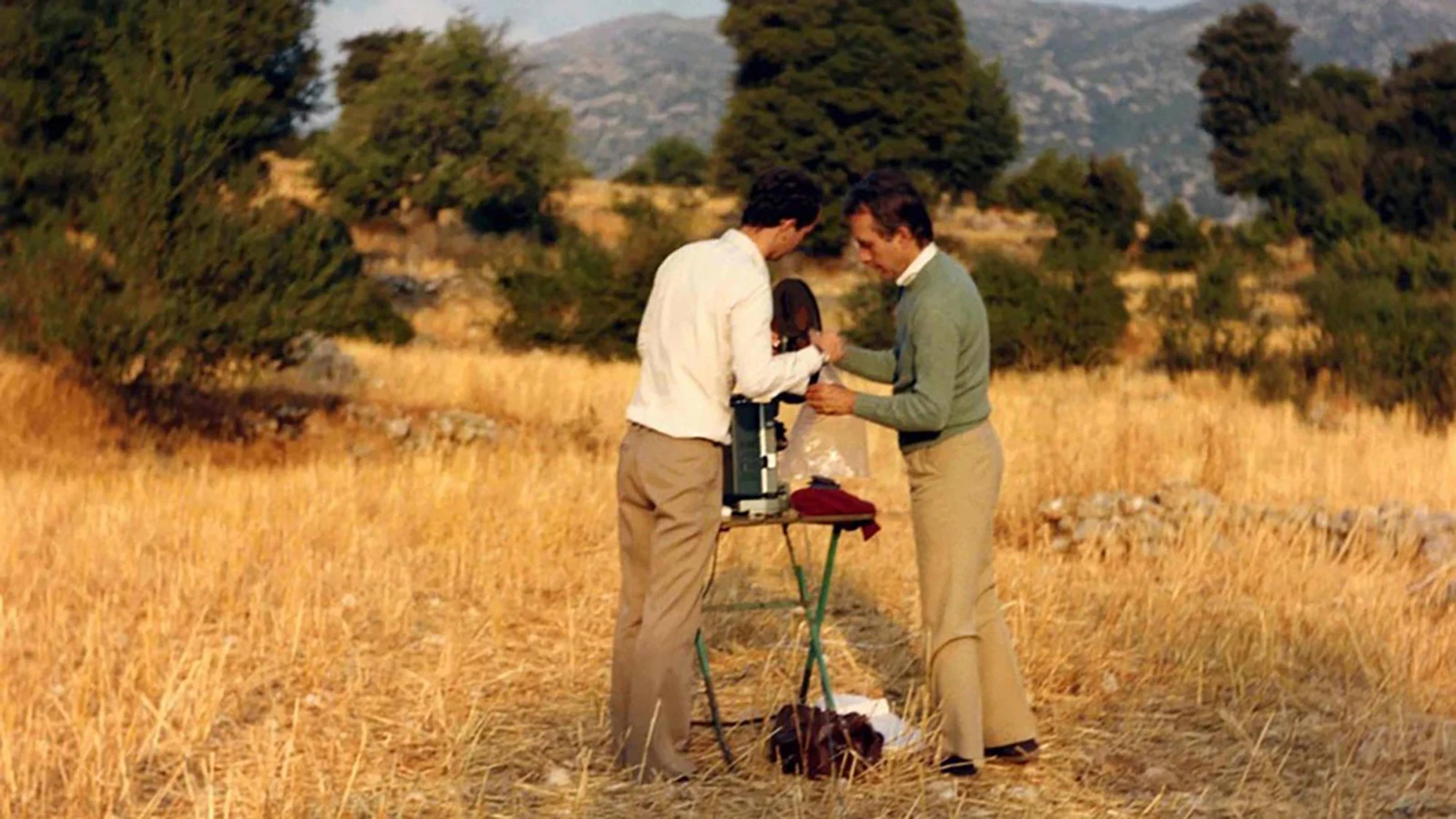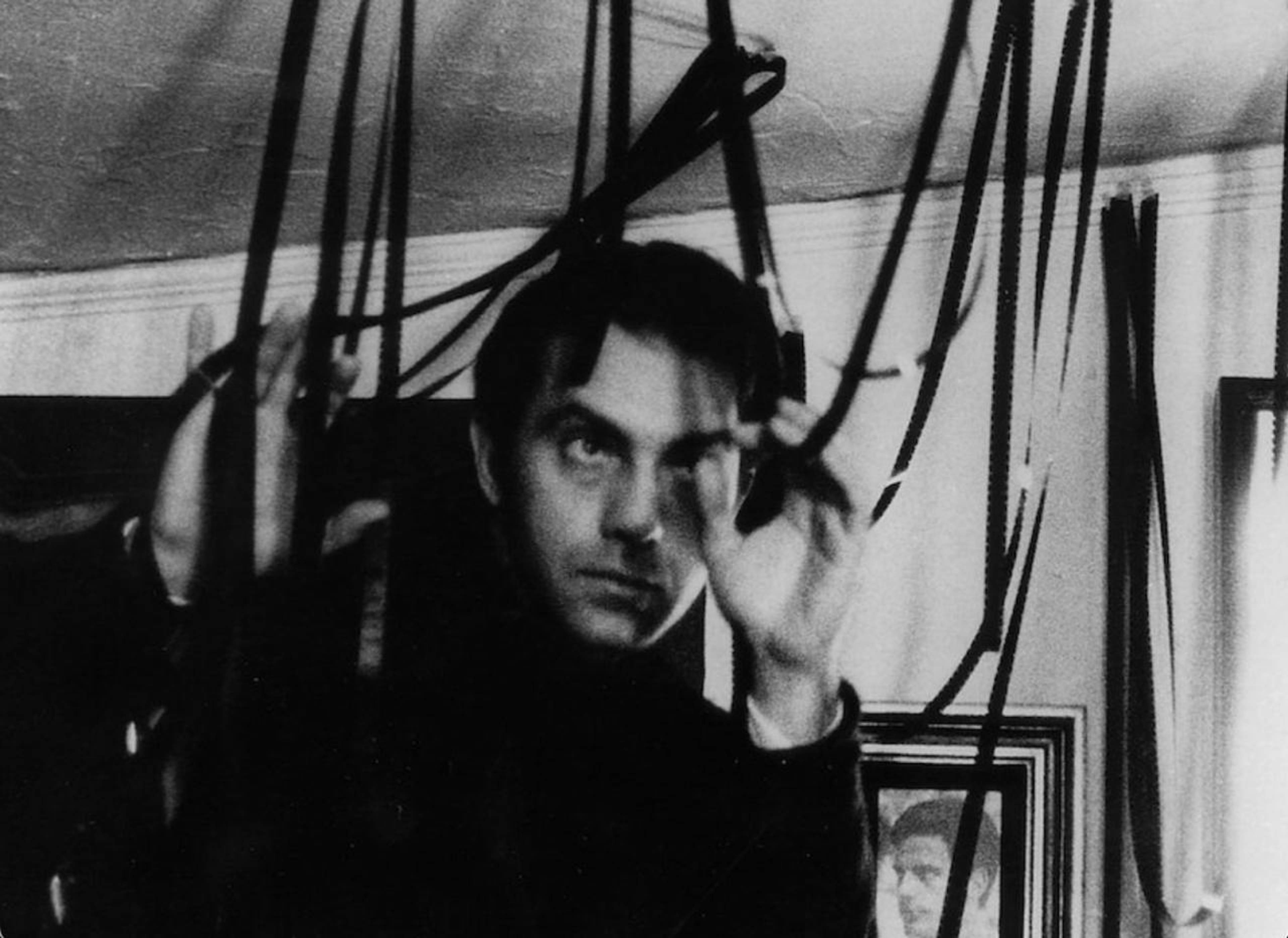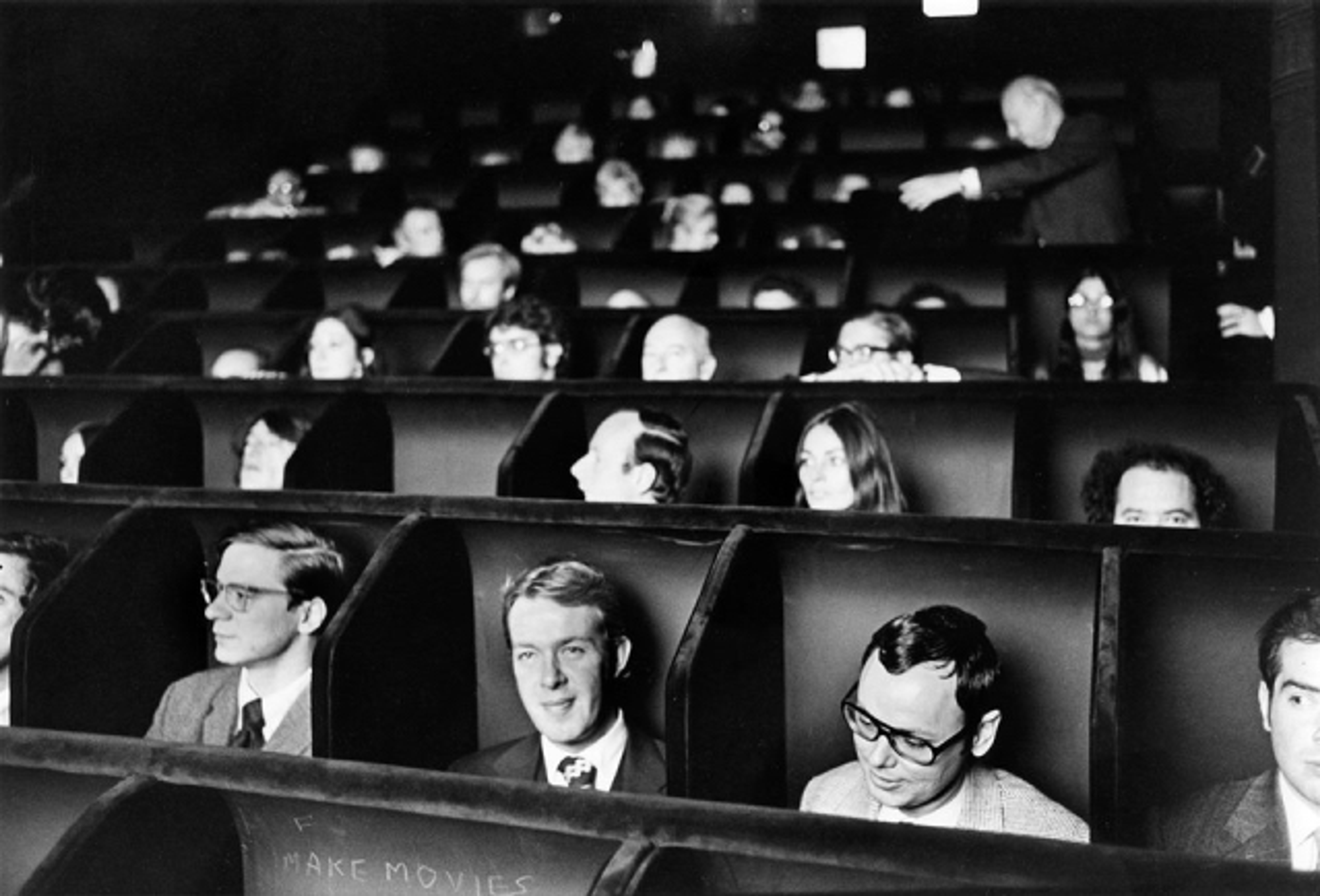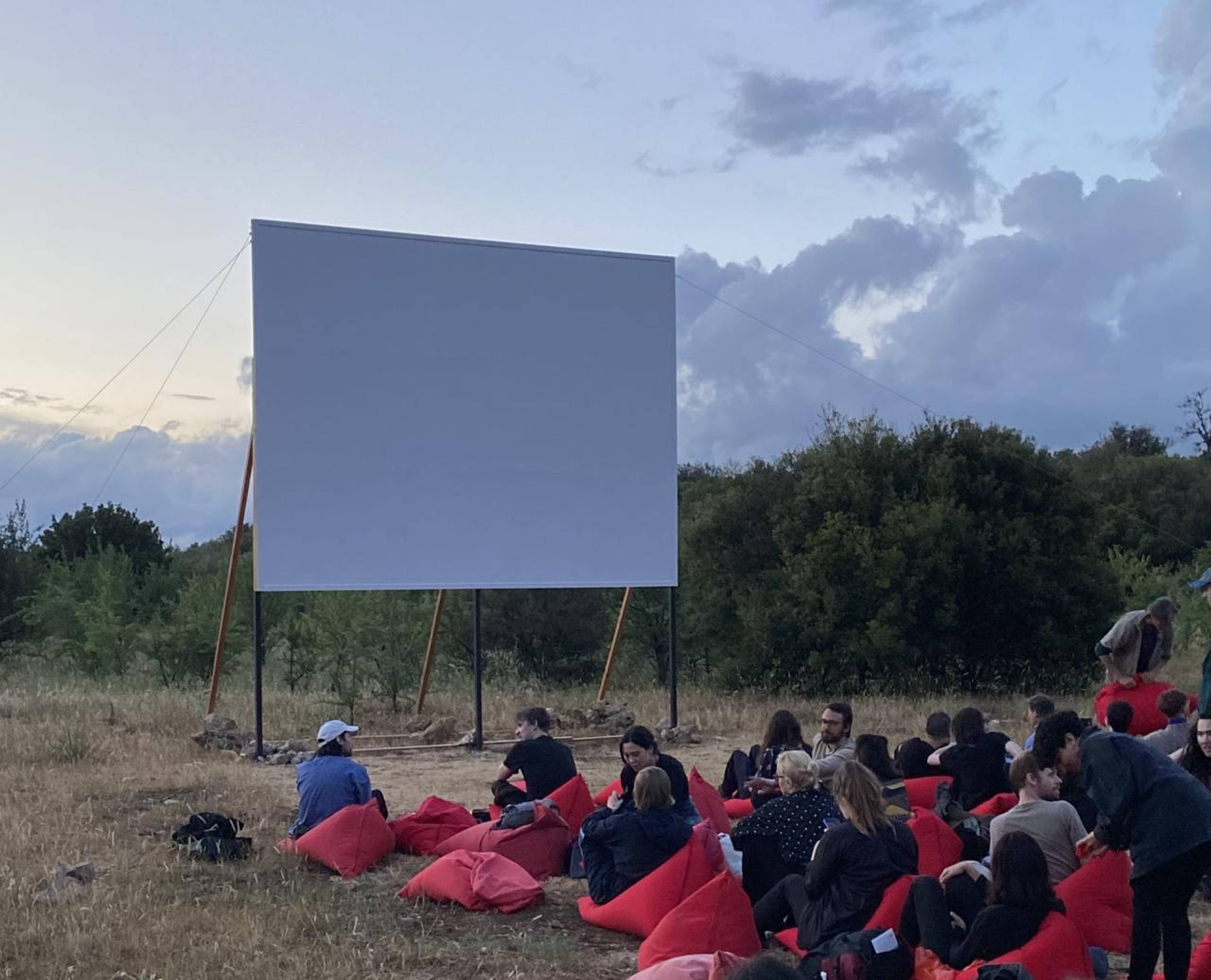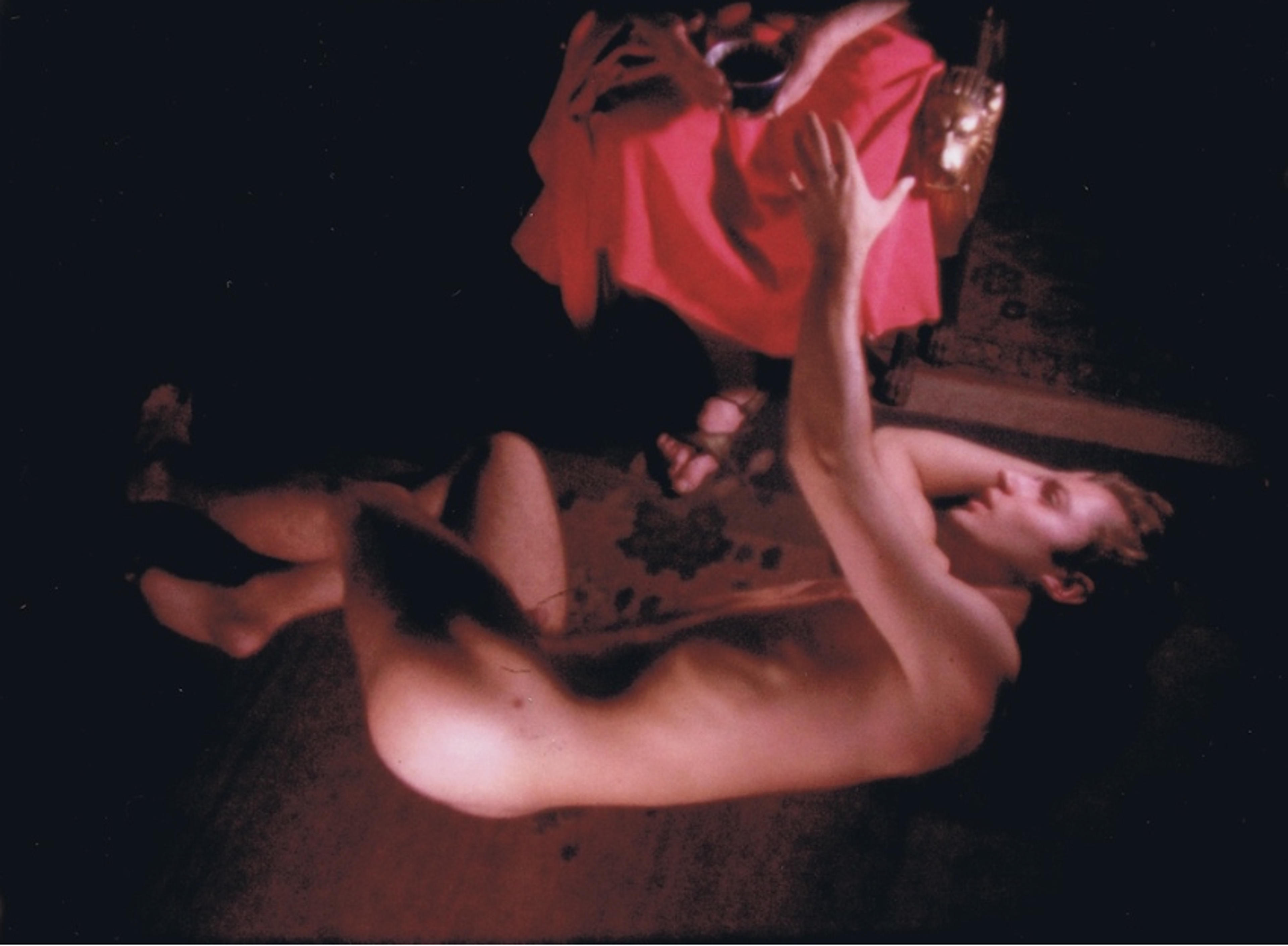The night before leaving for Greece, I couldn’t sleep, and as I’d been doing in recent weeks when feeling insomniac – the sun hardly sets in Berlin in mid-summer – I found myself wandering the strange corner of the internet occupied by “angelicism01,” the baroquely cryptic Substack full of grievance-filled manifestoes on internet culture and links to fellow travelers within the so-called vibe shift.
Soon enough, my screen was flooded with tab after tab of unsettling and unaccountably addictive content: gloomy videos in which portentous robot-voiced narrators announce the dawn of a “pure vibe”; anonymous Twitter accounts with Milady profile pics making cryptic, intentionally misspelled proclamations like “i need yuo to be absolutely internet-maxxing; i need yuo to hav vivid hypnagogic hallucniatoins of twitter notifications ...”; mumbly podcasts where an edgelord artist named Charlotte Fang advocates “dissolving your subjectivity into pure cybernetic data” via the liberating jouissance of “schizoposting” and shilling ironically bad NFTs.
If this online territory has any dark allure, it’s in the way its riffing on the internet’s infinitude of imagery reflects our media-poisoned landscape in all its ragged profanity. As with anything profane and determined to arrest stray eyeballs – whether an “art project” or a simple grift for internet attention – it gets harder to divert your focus as the night wears on. What’s more, bestowing your attention on these smirking nihilists for such an extended stretch can feel like a tacit endorsement of their grim worldview – that all cultural production reduces to mere babble in the face of technology, that the only avant-garde remaining as we bumpily settle into the 21st century is cynical, accelerationist submission to the timeline’s bleak dopamine regime.
It was a fortunate happenstance, then, that my destination in Greece, a film festival in the mountains of Arcadia called “the Temenos,” billed itself as a balm and a salve – if not the outright salvation – for an age of media saturation. “Billed itself” is the wrong phrase; the Temenos is about as remote and publicity-averse as a festival can get. “Festival” is also perhaps an inaccurate term; the Temenos, rather, is the grand vision and final artistic statement of Gregory Markopoulos, an experimental filmmaker with a borderline messianic conviction that his work had the power to redeem our media-polluted epoch. The project he spent his final years developing was so ambitious, utopian, and possibly megalomaniac it has engendered a cult fascination among a small community of film lovers, who make a pilgrimage to the Greek Peloponnesus every four years to witness its latest posthumous installment.
Gregory Markopoulos
The Temenos attracts a specific segment of the film-going public. Those who travel from Europe mostly hail from Germany and Greece, and are a mixture of artists, filmmakers, and people like me who’ve stumbled into the event accidentally. The people from the US tend to be film-studies academics and hardcore cinephiles – the type who might make an annual trip to the Nitrate Picture Show in Rochester, famous for screening cellulose-nitrate 35mm prints from the 1940s that can self-combust at any moment. Even among the latter group, for whom seeking out rare cinematic experiences is a full-on lifestyle, the Temenos is regarded as a sort of Holy Grail of esoteric film screenings.
It was inevitable, perhaps, that the Temenos would accumulate a cultish aura. Markopoulos intentionally encouraged this, and his life happened to be the stuff of legend, more akin to a 19th-century picaresque or invented Roberto Bolaño biography than a 20th-century professional arts career. Born in Ohio to Greek parents in 1928, Markopoulos became a pioneering figure in New York’s avant-garde film scene of the 1950s and 1960s, regarded as a heavyweight among figures like Stan Brakhage, Kenneth Anger, and Jonas Mekas – with whom, in 1960, he helped co-found the influential New American Cinema Group.
In 1968, however, Markopoulos became frustrated with the conditions for financing and screening experimental films, and he denounced his peers and departed the United States for Europe, never to return. With him was his life partner Robert Beavers, himself a burgeoning filmmaker and nineteen at the time. Together they’d lead a life of astonishing austerity, refusing permanent lodging of any sort, spending nearly three decades roaming the hotels and pensions of Western Europe. The extremity of their itinerant lifestyle – something Markopoulos seemed to understand as a bid to escape the commercialism and encroaching institutionalization of art-making in the 1970s – is illustrated in a Brooklyn Rail essay by Rebekah Rutkoff: in the year 1986 alone, according to Beavers’s notebooks, the couple logged 111 separate train journeys, averaging one relocation every three days.
Markopoulos claimed he’d developed a radically original and stripped-down method of filmmaking, one that had the potential to spiritually heal viewers
But the asceticism wasn’t merely a matter of lifestyle. Once in Europe, although he continued shooting films, Markopoulos stopped showing new work in any form or fashion. He claimed he’d developed a radically original and stripped-down method of filmmaking, one that had the potential to spiritually heal viewers in a manner inspired by ancient Greek asclepieia – temples where pilgrims were sent into trance-like states in order to receive cures via their dreams. Yet he wouldn’t demonstrate his approach until he’d located an ideal projection environment, something he took to calling “my Temenos of the 21st Century,” an antithesis to the “filthy” and “commercial” cinematheques that typically screened experimental films. (Temenos is a Greek term meaning “sacred grove.”) In 1975, for example, when curators of the just-announced Pompidou Centre approached him about acquiring films for their archive, he told them he’d be willing to gift his collected works only under the condition that a forty-seat theater were built to his specifications, which would exclusively screen Markopoulos and Beavers films. The Pompidou declined.
The Anthology Film Archives, New York
Over the ensuing years, Markopoulos developed an increasingly enigmatic cosmology surrounding his Temenos project. He took copious unpublished notes – some sixty-five volumes he catalogued and stored in a bank vault in Switzerland – in which he gnomically referred to himself as a “filmmaker physician,” dedicated to restoring the lost preeminence of “film as film.” It wasn’t until the 1980s that he located his ideal site, a small clearing outside a Peloponnesian village called Lyssaraia where his father had grown up. Markopoulos’s choice framed the Temenos as a sort of cinematic Bayreuth in his ancestral backyard, and he’d spend the rest of his life preparing the Gesamtkunstwerk he intended to show there, a magnum opus called Eniaios, composed largely of brief shots repurposed from earlier works, interwoven with blank stretches of black and white film leader. It took over a decade of painstaking labor to assemble the film, as Markopoulos glued by hand the upward of twenty thousand cement splices that structure it. When he died of lymphoma in 1992, he’d just barely finished Eniaios, a 167-reel behemoth that would take eighty hours to screen in its entirety. Because he cut it using original camera negatives, he never saw it projected before he died.
It was left to Beavers, who’d become a significant filmmaker in his own right, to conceive how to organize Temenos screenings and make the film screenable – the negatives of Eniaios couldn’t be run through a projector, so Beavers needed to cobble together funding to have projection copies printed from the handcrafted version. This would take years, and in a further obstacle, Markopoulos’s cement splices began disintegrating after a decade or two, so Beavers (alongside, more recently, a team of Berlin-based volunteers) has needed to repair each splice individually before any reel can be sent off to a printing lab. In a Q&A at this year’s Temenos, Beavers said the total costs have run to nearly $900,000 dollars so far.
In 2004, Beavers established the ongoing format of Temenos screenings: every four years, for three consecutive nights after the sun has set, he premieres approximately ten hours of Eniaios in the open air outside Lyssaraia. Before this point, neither he nor any attendee has seen that stretch of the film. For anyone who makes the pilgrimage to Temenos, the experience is shaped profoundly by Beavers’s unwavering faith in Markopoulos’s conviction that, in a 21st century he could only hypothesize, people would flock from far and wide to pay homage to – and possibly receive some kind of psycho-sensual healing from – his work.
The faith has been rewarded. Nearly two hundred of us arrived again this year to witness the first screenings since the summer of 2016. (COVID forced the cancellation of the 2020 screenings, so the final ten hours likely won’t premiere until 2034.) My first trip was in 2012, when P. Adams Sitney, a film scholar with whom I took a mind-expanding course in college, visited Berlin one semester and mentioned off-handedly that, if I found a flight to Athens and brought my own tent, I could attend the Temenos essentially for free. Why not? I was 24. I camped in the hills above the projection site and had a grand time, drinking a bootleg brandy called tsipouro all day and attending the screenings in a mystified haze at night. I returned in 2016, bringing my partner and some friends along, still baffled by Eniaios, but increasingly awed, as I aged into more deadlines and responsibilities, by Markopoulos’s total refusal to compromise on his singular vision. I purchased Markopoulos’s collected writings, Film as Film, and paged through them intermittently over the intervening years, trying and mostly failing to understand the theoretical underpinnings of his work.
After a series of insomniac nights in a vibe shift wormhole, I set off to Greece for another round, wondering if this year I needed the filmmaker physician more than ever.
This year would mark my pilgrimage, so, in a fit of writerly confidence, I pitched a piece to Spike, something I imagined as an on-the-fly experience report where I’d relate my shifting impressions over three Temenos nights, my critical perspicacity sharpened by a full decade of hindsight. After a series of insomniac nights in a vibe shift wormhole, I set off to Greece for another round, wondering if this year I needed the filmmaker physician more than ever.
* * *
Arriving to the Temenos is a logistically complicated operation. There’s no international airport on the Peloponnesian peninsula, so most attendees fly into Athens, three hours away. Chartered buses ferry you from Athens to a handful of small towns surrounding Lyssaraia, since Lyssaraia, with a permanent population of about twenty, is too small to host non-camping guests. During the day, you’re left to your own devices, but each night after dinner you pile into buses and head to the Lyssaraia town square. From there, as the sun sets behind the mountains of Arcadia, it’s a 45-minute walk down a pebbly ravine to the Temenos site.
The site itself is stunning, a former agricultural terrace with views of Olympia to the west and the Ionian Sea to the south. Every four years, a team of dedicated organizers helps Beavers empty the field of snakes and fill it with red beanbags made by a tailor in Athens. At the far end of the clearing, a huge white screen is erected on stilts, while behind the beanbags a 16mm projector is mounted on a tall wooden pedestal. A projectionist, Kathryn MacKay, is flown in from the Pacific Film Archives in Berkeley. When the sun has finished setting and the stars have begun emerging, three to four reels of Eniaios – one “cycle” in Markopoulos’s terminology – are screened, after which viewers hike back up the ravine, board the buses, and head home to their respective guesthouses. Your head hits the pillow around two or three in the morning. Rinse, wash, and repeat for three days.
The Temenos prior to the screening. Photo: Rob Madole
Considering all the effort, it’s no surprise that there was a crackle of anticipation hovering in the air the first night. With the COVID delay, it had been six years since the last screenings, plus there’d been a forecast of rain all week that had only been lifted an hour before our hike – a gift from the cinephile gods. As we settled into our beanbags and the first stars began twinkling in the sky, Robert Beavers delivered a short thank-you speech. “Gregory’s notes,” he concluded, “mention that tonight has ‘French themes.’ Please enjoy.” With that, a hush fell over the audience, the projector began to click and whir, and the fiftieth hour of Eniaios began. Almost immediately, as the first stroboscopic flashes began to appear on the screen, a pit of dread opened in my stomach. What had I been thinking, pitching an article about Eniaios? Was I capable of writing anything coherent about this film? I wasn’t certain I could make it through three more hours of it, let alone three nights.
As your brain struggles to adjust, you find yourself desperately trying to fix in your mind’s eye what the color images might be ( was that a man with a cigar? A pergola in a garden? ) before Markopoulos yanks them away and begins blitzing you again, unrelentingly, with his pulsing flashes.
So far I’ve been a little coy about the single most defining feature of Eniaios, which confronted me again in its full force during those opening moments: Eniaios is composed almost entirely of black and white flashes. There are lush color images in between the flashes, hundreds of them, harvested largely from Markopoulos’s earlier forty films – which he sometimes disassembled the only copies of to stitch together his masterwork – but they are vanishingly brief, often lasting no longer than half a second before being superseded by more flashes of black and white. The flashes are complexly patterned, lasting anywhere from two to twenty seconds, alternating in strobe-like rhythms that vary immensely over the film’s 80 hours, but they’re nevertheless bare and empty, entirely bereft of content.
As your brain struggles to adjust, you find yourself desperately trying to fix in your mind’s eye what the color images might be (was that a man with a cigar? A pergola in a garden?) before Markopoulos yanks them away and begins blitzing you again, unrelentingly, with his pulsing flashes. For the first few minutes, it can feel like you’re undergoing some sort of abstruse science experiment – try and identify mystery photos based only on their hypnagogic after-image, while being bathed in bafflingly specific rhythms of black and white.
The Temenos prior to the screening. Photo: Rob Madole
What were Markopoulos’s intentions? I’ve spent a decade hypothesizing about the flashes, but I’ve never developed a unified theory. Following every Temenos since 2004, P. Adams Sitney has written a comprehensive report for Artforum, where he tends to focus on how Eniaios ’s color images recontextualize earlier works in Markopoulos’s filmography (what does it mean, for example, that all 22 cycles of Eniaios feature frames from the 1967 film The Iliac Passion, Markopoulos’s recreation of the Prometheus myth?). When Sitney does write about the flashes, he emphasizes how they create stasis around the images, providing a framework for “amassing rhythms” over the length of the film. They also, he argues, function to isolate cinema’s foundational elements (light, projected frame, montage) and illustrate for viewers the illusion of movement at its very core: our brains only trick themselves into perceiving a moving image when the framerate exceeds 24 frames per second, so Markopoulos’s rapid-fire montages, often only a single color frame surrounded by black and white flashes, “hammer home the mechanical limit of cinematic time.”
One of the few other scholars to have written about Eniaios is Rebekah Rutkoff, who speculates that the flashes are bound up with Markopoulos’s “filmmaker physician” mythology. The flickering is intended to activate within spectators some kind of hallucinatory “incubation” – a term describing the cure sought by sick pilgrims of ancient Greece who’d visit temples devoted to Asclepius, the god of healing, in hopes of being implanted with therapeutic dreams.
Markopoulos himself, despite his enormous breadth of writing on the Temenos, only makes occasional, evasive mentions of the flashes, an obliquity I can’t help seeing as intentional. (“In the Temenos there must be a secret – what secret?” Rutkoff reports him noting in the margins of a book about ancient asclepieia.) One essay from 1971, however, gushes about a new montage technique he’s developed, which he believes will engender in his audience a “counterpart effect similar to the dialogues of Plato.” In other words, he seemed to see his flashes as a sort of dialectical process, eliciting viewers to react by supplying speculative projections from their own visual consciousness. In our media-polluted epoch, where practically every spare second is occupied by a glance at a phone, it’s not hard to imagine how this might prove therapeutic. A typically cryptic Markopoulos pronouncement: “I wish the spectator of the Temenos to perceive what is not at times visible. In this is the essence of the spectator’s Inspiration.”
Another: “It is the slowness of anticipation, fatigue, and boredom ... that in turn creates the content which is for me the film as film.”
* * *
My Temenos plan had been to keep a fast-paced log of analytical insights, but all I could manage that opening night was to compile a running list of images: an elderly lady beside some lighted stairs, a dog beside her leg, a closeup of her glasses, a closeup of the stairs behind her, her shoes on a carpet. Toward the end of the evening, a man sprawled across some kind of stretcher, naked, writhing in front of a black chiaroscuro background. For a long time, I couldn’t tell if I was looking at his penis or his head. (It turned out that the image – a scene from The Iliac Passion – was being flipped upside down and rightside up, so the answer was both.)
I tried to figure out what was happening, and decided that my torpor wasn’t because I was distracted, as I’d feared in the opening minutes, but because the sheer effort of fixing my attention on Eniaios was obliterating the language-making part of my brain. This was an effect I remembered finding disturbing in earlier years, but eventually succumbing to in a kind of meditative stupor. This year, however, an intrepid reporter, I was determined to build a phenomenological picture of what was happening. One important factor seemed to be that, as objectively boring and uneventful as Eniaios might be – at least by any commercial standard – it’s not something my brain could engage with passively. Markopoulos’s rapid-fire cuts and splices did seem to stimulate my nerves in some deep physiological way; I could actually feel my pupils contracting and expanding with every flash from black to white.
Eventually, though, the film seems to achieve a sort of optical entrainment, because it stops being difficult to make out the images. Uniformly, they’re painterly and haunting compositions, invested with a dim luminosity that’s only possible in 16mm celluloid. They’re complexly arranged, juxtaposing for instance a portrait of Jasper Johns with images of the Sforza Cesarini castle in Lazio, suggesting some kind of thematic resonance. Although they have a classical and staged quality, at the same time there’s something deeply personal and revealing about them, as if conjured and exalted out of the daily stream of Markopoulos and Beavers’s itinerant life.
Nevertheless, I found it nearly impossible to read any sort of hermeneutical schema into their arrangement. Partially this was because the film was perpetually operating on me, refusing to allow me any relief from the flashes, such that any in-the-moment interpretation I might offer about the images couldn’t be couched in the realm of signification or language. I wondered if this was what Markopoulos meant by the term “film as film” – a strategy of removing cinema from its narrative or theatrical trappings, and reconceiving it as a kind of pure hallucinatory visionscape. At the same time, Eniaios’s arrangements, rhythms, and rhymes are clearly coordinated in a manner to avoid letting you enjoy them in passive contemplation, instead demanding an active response from your interpreting brain. The result is to set you adrift in your unconscious, watching yourself watch Eniaios. A heady experience, once you steel yourself to submit to it.
Still from Gregory Markopoulos, The Illiac Passion, 1967, 92 min.
I wondered if I’d have wild, therapeutic dreams that first night, but my sleep was dreamless. Even so, by the time we’d settled into the beanbags for our second cycle, I felt a strange surge of elation. After ten years of attendance, there was something vatically familiar about the copse of trees to the right, the moon rising over our left shoulders and crossing the sky toward the screen, the clatter of the projector in the background, even the relief at the tick-ticking sound of a reel reaching its final frames. That night’s cycle happened to feature the most movement and densest imagery of any I could remember. A shot of Peggy Guggenheim in a park, flipping spasmodically around the x-and-y axes for minutes at a time, nearly knocked me off my beanbag in surprise, marveling that Markopoulos had managed to wait thirty patient hours before deploying one of the more whiz-bang effects available in his idiosyncratic film vocabulary. At a different point, a shot of a hand clenching lasted for a remarkable three full seconds; this corresponded with a massive comet streaking across the sky, so it wasn’t clear which circumstance drew the collective gasp.
the Temenos is a three-day immersion into an alternative way of engaging with moving images, imagining what they might incubate in our imaginations if divested of all their freight of commerce, entertainment, and passive reception.
It was around this point that a feeling began to incubate in me. During a break between reels, I’d guiltily checked my email and noticed another Substack missive from “angelicism01,” this one hinting it had been composed with the help of an AI language generator. I’d forgotten about the vibe shift, I realized, and I was surprised at the strange resemblance between the email’s wording and Markopoulos’s allusive writings. I began thinking about the convergences and contrasts between the cynical trolling of the art world undertaken by vibe shift figures like angelicism and Charlotte Fang and Markopoulos’s thoroughgoing, monastic rejection of it. While both were adopting a cultish, prophetic orientation toward the future, conceiving of their work quite distinctively as 21st-century experimental media projects, the vibe shifters offered only a cynical celebration of meaning’s “extinction” in an age of media saturation, metabolized as a supposedly avant-garde pseudo-spirituality rooted in accelerationist posthumanism. Markopoulos, on the other hand, offered something redemptive and thoroughly humanist: without being Luttidic or revanchist, in fact being as brazenly experimental as filmmaking can get, the Temenos is a three-day immersion into an alternative way of engaging with moving images, imagining what they might incubate Eniaios in our imaginations if divested of all their freight of commerce, entertainment, and passive reception. I can’t say it cured me of my media addiction – I was back to my old habits within a few days of returning to Berlin – but it seemed to reactivate, at least for a few hours, a part of my brain that had atrophied from having so many images passively spoon-fed to it over the past six years. Even weeks later, Markopoulos’s images still surface in my imagination in quiet moments, charging my day with a new significance.
On the final evening, as he does every year, Robert Beavers hosted a short Q&A. Temenos attendees are typically bristling with questions: Was Gregory reading Parmenides when he conceived Eniaios? Are the flashes spaced in multiples of twenty-four to rhyme with our frame-rate perception? Beavers is always studiously evasive, respectful of Markopoulos’s impulse to sidestep interpretation. He’s just a “fellow spectator,” he demurred. At a certain point he began reminiscing about his arrival to New York in 1965, when he first witnessed Markopoulos’s films and decided to become a filmmaker. The 1960s were a fecund moment in avant-garde cinema, he recalled, but they were brief – and they quickly transitioned from a state of “everything being forbidden, to everything being sold.” Which is where we find ourselves today.
In carrying out Markopoulos’s vision for the Temenos, Beavers wanted to offer a different inspiration to young filmmakers: “the strength to think that they will not be stopped.” “Film,” he continued, “is only at its beginning, you know.” Lost in my media wormhole before the trip, I’d never imagined finding this a consoling thought. Now, I did. The early 21st century is shaping up to be a cultish era, and though the cult of Markopoulos is still in its infancy, it strikes me as one of the hopeful ones.
___


